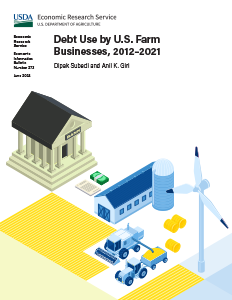Debt Use by U.S. Farm Businesses, 2012–2021
- by Dipak Subedi and Anil K. Giri
- 6/26/2024
Overview
The short-term Federal funds rate, which impacts the interest rate of other loans, has been increasing since March 2022. The rate can disproportionately affect demand for different types of loans, as well as the choice of the lender for different farm sizes. This report examines farm debt by lenders, as well as other attributes, such as the use of different loan types (real estate and non-real estate) among different types of farm businesses. The authors used data from multiple sources, including the USDA, Economic Research Service's Farm Income and Wealth Statistics and Agricultural Resource Management Survey (ARMS), from 2012 to 2021 to understand the farm debt situation. Total U.S. farm debt in 2021 was $503.7 billion (in 2022 dollars), which was $127.8 billion (34 percent) higher compared with 2012 and was primarily driven by farm real estate debt. Total farm real estate debt was $344.5 billion, or more than two-thirds of total debt in 2021. The Farm Credit System, a nationwide network of borrower-owned lending institutions and specialized service organizations, provided 45 percent of total debt, and commercial banks provided 35 percent, resulting in these two lender entities providing 80 percent of the sector’s debt. The share of farm businesses with some debt grew as gross cash farm income increased along with the average and median loan size.
How to Cite:
Subedi, D., & Giri, A. K. (2024). Debt use by U.S. farm businesses, 2012-2021 (Report No. EIB-273). U.S. Department of Agriculture, Economic Research Service. https://doi.org/10.32747/2024.8478364.ers
Download
-
Entire report
Download PDF -
Report summary
Download PDF
We’d welcome your feedback!
Would you be willing to answer a few quick questions about your experience?

